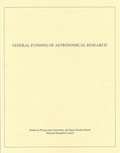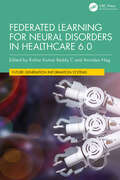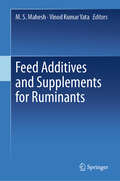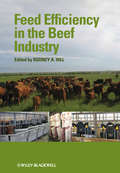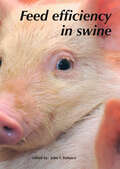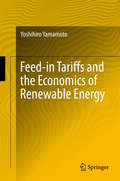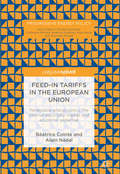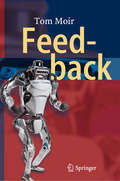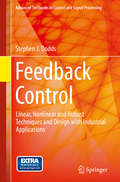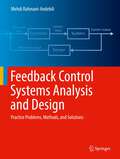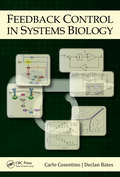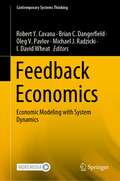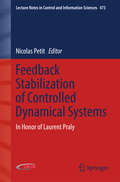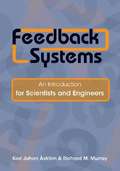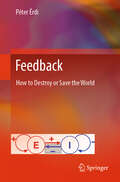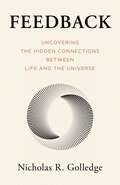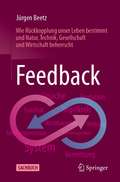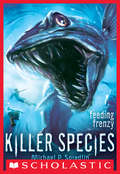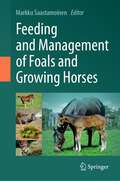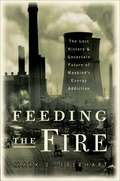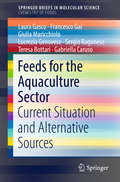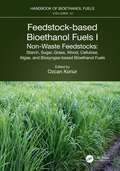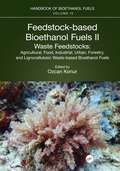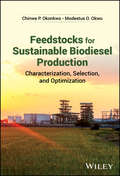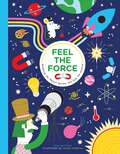- Table View
- List View
Federal Funding Of Astronomical Research
by Committee on Astronomy AstrophysicsThe National Academies Press (NAP)--publisher for the National Academies--publishes more than 200 books a year offering the most authoritative views, definitive information, and groundbreaking recommendations on a wide range of topics in science, engineering, and health. Our books are unique in that they are authored by the nation's leading experts in every scientific field.
Federated Learning for Neural Disorders in Healthcare 6.0 (Future Generation Information Systems)
by Anindya Nag Reddy C, Kishor KumarThis reference text offers a relevant and thorough examination of the overlap between neuroscience and federated learning. It explores the complexities of utilizing federated learning algorithms for MRI data analysis, demonstrating how to improve the accuracy and efficiency of diagnostic procedures. The book covers topics such as the prediction and diagnosis of Alzheimer’s disease using neural networks and ensuring data privacy and security in federated learning for neural disorders.This book: Provides a thorough examination of the transformative impact of federated learning on the diagnosis, treatment, and understanding of brain disorders Focuses on combining federated learning with magnetic resonance imaging (MRI) data, which is a fundamental aspect of contemporary neuroimaging research Examines the use of federated learning as a promising approach for collaborative data analysis in healthcare, with a focus on maintaining privacy and security Explores the cutting-edge field of healthcare innovation by examining the interface of neuroscience and machine learning, with a specific focus on the breakthrough technique of federated learning Offers a comprehensive understanding of how federated learning may transform patient care, covering both theoretical ideas and practical examples It is primarily written for graduate students and academic researchers in electrical engineering, electronics, and communication engineering, computer science and engineering, and biomedical engineering.
Feed Additives and Supplements for Ruminants
by Vinod Kumar Yata M. S. MaheshThis book comprehensively reviews various feed additives and supplements that are employed for ruminant production and health. It discusses important strategies of using additives and supplements through rumen fermentation, immunomodulation, nutrient utilization, and cellular metabolism that lead to enhanced milk production, body weight gain, feed efficiency, and reproduction. The book also presents the importance of nutritional supplements such as B-vitamins, advances in mineral nutrition, role of lesser-known trace elements, protected amino acids, slow-release nitrogen and rumen buffers on performance and health of ruminants. In addition, the book explores strategies for improving environmental stewardship of ruminant production by minimizing carbon footprint associated with greenhouse gas emissions, enhancing ruminant-derived food safety through mycotoxin binders, exogenous enzymes, probiotics, flavours, biochar, ionophores, seaweeds and natural phytogenic feed additives with an emphasis on plant secondary metabolites (tannins, saponins and essential oils, etc.). It also details information on silage additives, additives and supplements employed in successful calf rearing, transition cow management as well as to ameliorate the adversity of heat stress in ruminants. Overall, the book is valuable for veterinary and animal science researchers, animal producers, nutrition specialists, veterinarians, and livestock advisors.
Feed Efficiency in the Beef Industry
by Rodney A. HillFeed Efficiency in the Beef Industry provides a thorough and concise overview of feed efficiency in beef cattle. It frames the great importance of feed efficiency to the industry and details the latest findings of the many scientific disciplines that intersect and aim to improve efficient and sustainable production of nutritious beef. The vast majority of production costs are directly tied to feed. With increased demand for grains to feed a rapidly increasing world population and to supply a new demand for alternative fuels, feed costs continue to increase. In recent years, the negative environmental impacts of inefficient feeding have also been realized; as such feed efficiency is an important factor in both economic viability and environmental sustainability of cattle production.Feed Efficiency in the Beef Industry covers a broad range of topics ranging from economic evaluation of feed efficiency to the physiological and genetic bases of efficient conversion of feed to high quality beef. Chapters also look at how a fuller understanding of feed efficiency is leading to new selective breeding efforts to develop more efficient cattle.With wide-ranging coverage from leading international researchers, Feed Efficiency will be a valuable resource for producers who wish to understand the complexities, challenges, and opportunities to reduce their cost of production, for students studying the topic and for researchers and professionals working in the beef industry.
Feed efficiency in swine
by John F. Patience'Feed efficiency in swine' has been prepared as a comprehensive treatise on the current state of our understanding of this topic which is so important to the pork industry. Each chapter is written by international authorities who understand both the science and application of their topic area. The book provides detailed insight into the many factors affecting feed efficiency, ranging from diet processing to herd health, from nutrition to physiology and from day-to-day barn management to the adoption of advanced technologies. The authors explain such practical aspects as the challenge of interpreting feed efficiency information obtained on farm or the role of liquid feeding. The authors also delve into more scientific topics such as amino acid or energy metabolism or animal physiology. This book is written for people who have a technical interest in pork production, including nutritionists, geneticists, farm management specialists, veterinarians, other academics and, of course, pork producers.
Feed-in Tariffs and the Economics of Renewable Energy
by Yoshihiro YamamotoThis book offers a theoretical model of feed-in tariffs and provides different investigations into the promotion of renewable energy. The first part of the book proposes a model to investigate feed-in tariffs, that is, how to set a price for the electricity generated from renewable energy sources and fed into the power grid. The second part examines other important features of renewable energy development, such as uncertainty, diffusion of innovation, partnership among relevant parties, and community. Aiming for applicable results, this book provides a theoretical basis for the design of an effective, efficient, and tractable system for promoting renewable energy. This book is meant for researchers, policy makers, graduate students, and anyone interested in the economic and social aspects of renewable energy development.
Feed-in tariffs in the European Union
by Alain Nadaï Béatrice CointeThis book is a sociological account of the historical trajectory of feed-in tariffs (FITs) as an instrument for the promotion of renewable energy in Europe. Chapters analyse the emergence and transformations of feed-in tariffs as part of the policy arsenal developed to encourage the creation of markets for RES-E in Europe. The authors explore evolving conceptions of renewable energy policy at the intersection between environmental objectives, technological change and the ambition to liberalise the internal electricity market. They draw conclusions on the relationships between markets and policy-making as it is instituted in the European Union, and on the interplay between the implementation of a European vision on energy and national politics. Distinctive in both its approach and its methods the books aim is not to discuss the design of feed-in tariffs and their evolution, nor is it to assess their efficiency or fairness. Instead, the authors seek to understand what makes feed-in tariffs what they are, and how this has changed over time.
Feedback
by Tom MoirThis text ventures into areas which the majority of control system books avoid. It was written to look at the area in a much wider form than the usual process control or machine control-systems. Many topics which are covered in other specialities are covered such as the stability of amplifiers, phase-locked loops, structural resonance and parasitic oscillations. It also covers the application and implementation of real-time digital controllers and for the first time the Amplitude-locked loop. An even wider look at the area is shown by examining classical or historic mathematical algorithms in terms of control-theory. Despite its wide range, the book is tutorial in nature and tries to avoid where possible an obtuse mathematical approach. It comes with MATLAB, LabView and a few Mathematica examples. The book is an ideal undergraduate text for engineers and a refresher for many practising engineers. It gives a thorough background in the analogue domain before moving on to digital-control and its applications. The proceeds from author royalties of this book will be donated to charity.
Feedback Control
by Stephen J. DoddsThis book develops the understanding and skills needed to be able to tackle original control problems. The general approach to a given control problem is to try the simplest tentative solution first and, when this is insufficient, to explain why and use a more sophisticated alternative to remedy the deficiency and achieve satisfactory performance. This pattern of working gives readers a full understanding of different controllers and teaches them to make an informed choice between traditional controllers and more advanced modern alternatives in meeting the needs of a particular plant. Attention is focused on the time domain, covering model-based linear and nonlinear forms of control together with robust control based on sliding modes and the use of state observers such as disturbance estimation. Feedback Control is self-contained, paying much attention to explanations of underlying concepts, with detailed mathematical derivations being employed where necessary. Ample use is made of diagrams to aid these conceptual explanations and the subject matter is enlivened by continual use of examples and problems derived from real control applications. Readers' learning is further enhanced by experimenting with the fully-commented MATLAB®/Simulink® simulation environment made accessible at insert URL here to produce simulations relevant to all of the topics covered in the text. A solutions manual for use by instructors adopting the book can also be downloaded from insert URL here. Feedback Control is suitable as a main textbook for graduate and final-year undergraduate courses containing control modules; knowledge of ordinary linear differential equations, Laplace transforms, transfer functions, poles and zeros, root locus and elementary frequency response analysis, and elementary feedback control is required. It is also a useful reference source on control design methods for engineers practicing in industry and for academic control researchers.
Feedback Control Systems Analysis and Design: Practice Problems, Methods, and Solutions
by Mehdi Rahmani-AndebiliThis study guide is designed for students taking courses in feedback control systems analysis and design. The textbook includes examples, questions, and exercises that will help electrical engineering students to review and sharpen their knowledge of the subject and enhance their performance in the classroom. Offering detailed solutions, multiple methods for solving problems, and clear explanations of concepts, this hands-on guide will improve student’s problem-solving skills and basic and advanced understanding of the topics covered in these courses.
Feedback Control in Systems Biology
by Carlo Cosentino Declan BatesLike engineering systems, biological systems must also operate effectively in the presence of internal and external uncertainty-such as genetic mutations or temperature changes, for example. It is not surprising, then, that evolution has resulted in the widespread use of feedback, and research in systems biology over the past decade has shown that
Feedback Economics: Economic Modeling with System Dynamics (Contemporary Systems Thinking)
by Robert Y. Cavana Brian C. Dangerfield Oleg V. Pavlov Michael J. Radzicki I. David WheatThis book approaches economic problems from a systems thinking and feedback perspective. By introducing system dynamics methods (including qualitative and quantitative techniques) and computer simulation models, the respective contributions apply feedback analysis and dynamic simulation modeling to important local, national, and global economics issues and concerns. Topics covered include: an introduction to macro modeling using a system dynamics framework; a system dynamics translation of the Phillips machine; a re-examination of classical economic theories from a feedback perspective; analyses of important social, ecological, and resource issues; the development of a biophysical economics module for global modelling; contributions to monetary and financial economics; analyses of macroeconomic growth, income distribution and alternative theories of well-being; and a re-examination of scenario macro modeling.The contributions also examine the philosophical differences between the economics and system dynamics communities in an effort to bridge existing gaps and compare methods. Many models and other supporting information are provided as online supplementary files. Consequently, the book appeals to students and scholars in economics, as well as to practitioners and policy analysts interested in using systems thinking and system dynamics modeling to understand and improve economic systems around the world."Clearly, there is much space for more collaboration between the advocates of post-Keynesian economics and system dynamics! More generally, I would like to recommend this book to all scholars and practitioners interested in exploring the interface and synergies between economics, system dynamics, and feedback thinking." Comments in the Foreword by Marc Lavoie, Emeritus Professor, University of Ottawa and University of Sorbonne Paris Nord
Feedback Stabilization of Controlled Dynamical Systems
by Nicolas PetitThis book is a tribute to Professor Laurent Praly and follows on from a workshop celebrating the occasion of his 60th birthday. It presents new and unified visions of the numerous problems that Laurent Praly has worked on in his prolific career: adaptive control, output feedback and observers, stability and stabilization. His main contributions are the central topic of this book. The book collects contributions written by prominent international experts in the control community, addressing a rich variety of topics: emerging ideas, advanced applications, and theoretical concepts. Organized in three sections, the first section covers the field of adaptive control, where Laurent Praly started his career. The second section focuses on stabilization and output feedback, which is also the topic of the second half of his career. Lastly, the third section presents the emerging research that will form Laurent Praly's scientific legacy.
Feedback Systems: An Introduction for Scientists and Engineers
by Richard M. Murray Karl Johan Aström<p>This book provides an introduction to the mathematics needed to model, analyze, and design feedback systems. It is an ideal textbook for undergraduate and graduate students, and is indispensable for researchers seeking a self-contained reference on control theory. Unlike most books on the subject, Feedback Systems develops transfer functions through the exponential response of a system, and is accessible across a range of disciplines that utilize feedback in physical, biological, information, and economic systems. <p>Karl Åström and Richard Murray use techniques from physics, computer science, and operations research to introduce control-oriented modeling. They begin with state space tools for analysis and design, including stability of solutions, Lyapunov functions, reachability, state feedback observability, and estimators. The matrix exponential plays a central role in the analysis of linear control systems, allowing a concise development of many of the key concepts for this class of models. Åström and Murray then develop and explain tools in the frequency domain, including transfer functions, Nyquist analysis, PID control, frequency domain design, and robustness. They provide exercises at the end of every chapter, and an accompanying electronic solutions manual is available. Feedback Systems is a complete one-volume resource for students and researchers in mathematics, engineering, and the sciences. <p> <li>Covers the mathematics needed to model, analyze, and design feedback systems <li>Serves as an introductory textbook for students and a self-contained resource for researchers <li>Includes exercises at the end of every chapter <li>Features an electronic solutions manual <li>Offers techniques applicable across a range of disciplines</li>
Feedback: How to Destroy or Save the World
by Péter ÉrdiThe book offers an exciting, non-technical intellectual journey around applying feedback control to emerging and managing local and global crises, thus keeping the world on a sustainable trajectory. There is a narrow border between destruction and prosperity: to ensure reasonable growth but avoid existential risk, we must find the fine-tuned balance between positive and negative feedback. This book addresses readers belonging to various generations, such as: young people growing up in a world where everything seems to be falling apart; people in their 30s and 40s who are thinking about how to live a fulfilling life; readers in their 50s and 60s thinking back on life; and Baby Boomers reflecting on their past successes and failures. Albert-László Barabási, Robert Gray Dodge Professor of Network Science, Northeastern University: “In a world where interconnectedness has fostered global prosperity, it has also introduced vulnerabilities that can escalate local failures into worldwide crises. “Feedback” by Peter Erdi explores this double-edged sword, offering a solution through the power of feedback mechanisms. These tools are designed to mitigate the negative impacts of connectedness, steering the complexity of modern life towards outcomes that enhance human welfare.” Patrick Grim, Philosopher in Residence Visiting Scholar Center for Complex Systems University of Michigan: “Érdi demonstrates that many of the critical problems we face—from climate crises to economic instability to the threat of terrorism—operate as runaway feedback loops. The first challenge is to understand them. The second is to introduce control mechanisms on the model of biological homeostasis—a different form of feedback—that will guide us toward a more sustainable social future. Érdi applies the analytic tools of complex systems to some of the most complex issues we face.” Ichiro Tsuda, Specially Appointed Professor at Sapporo City University, Sapporo, Japan, leaving Chubu University Academy of Emerging Sciences (Director and Professor), Chubu University, Japan: “This book is dangerous, because of making your own consideration on feedback impossible to stop by a continual feedback process of yourself. Nevertheless, you must be given a method of finding very narrow boundaries between prosperity and destruction, therefore this book is extremely valuable. We all must read.”
Feedback: Uncovering the Hidden Connections Between Life and the Universe
by Nicholas R GolledgeWe live in a world where things come and go, rise and fall, grow and decay, tracing out cycles of change that are ordered and predictable.But amongst those well-behaved rhythms hide other phenomena, pulsing and fizzing and refusing to play by the same rules. Earth and the life upon it have evolved over billions of years to be right where we are now only because of feedbacks that pushed those systems until they broke. And then those systems adapted, reorganized, and rebuilt. With each new cycle of growth it was feedbacks that created order from disorder and gave rise to a world perfectly optimized for everything it needed to be. Now the latest scientific research is revealing that the exact same patterns that describe plate tectonics, evolution, and mass extinctions also emerge in the heartbeat of our everyday lives, underpinning everything from the cohesion of our social networks and personal relationships to our emotional well-being and spiritual beliefs. In Feedback, we embark on a backstage journey revealing how these lesser-known processes keep us operating right where we need to be, poised at the edge of chaos. In a world simultaneously threatened with social and environmental disasters this journey uncovers the hidden connections that unite us not just to those around us but also across vast scales of time and space to the very fabric of the universe
Feedback: Wie Rückkopplung unser Leben bestimmt und Natur, Technik, Gesellschaft und Wirtschaft beherrscht
by Jürgen BeetzFeedback wird im breiteren Sinne als Rückkopplung verstanden, nicht nur als verbale Rückmeldung. Rückkopplung ist das Rückführen der Wirkung auf die Ursache – und die verblüffenden Effekte sind in allen Lebensbereichen anzutreffen.Der Wissenschaftsautor Jürgen Beetz spricht Sie als Leser direkt an und entdeckt mit IhnenGeschichten des Alltags mit merkwürdigen Feedback-Effekten,die Selbstbezüglichkeit und die daraus entstehenden Widersprüche,die Eigenschaften komplexer dynamischer vernetzter Systeme,das Wesen der Rückkopplung, das aus diesen Bedingungen hervorgeht,Rückkopplungseffekte in der Technik, der Natur, der Gesellschaft, der Politik, der Wirtschaft ... und im Rest der Welt,das „mächtigste Konzept der Welt“, die Evolution.Sie verstehen, was passiert, wenn die Wirkung zur Ursache wird. Rückkopplung bestimmt unser Leben. Sie scheint oft im Verborgenen zu wirken. Wir bemerken sie erst, wenn sie ihr Werk schon getan hat. Manchmal voller Zufriedenheit, wenn sie stabilisierend war, aber oft mit Schrecken, wenn sie sich in einem „Teufelskreis“ aufgeschaukelt hat. Noch weniger ahnen wir, wie schwer sie oft zu durchschauen oder gar zu beherrschen ist. Aktuelle Krisen mit oft hochkomplexen Rückkopplungen führen uns das täglich vor Augen. Nach der Lektüre dieses Buches sehen Sie genauer hin.Das Werk ist in der zweiten Auflage vollständig durchgesehen und erweitert. Hinzugefügt wurde ein Abschnitt über das dynamische Verhalten von Systemen.Stimmen zur ersten Auflage„Ein wichtiges Buch, das ein zentrales Element kreativer Entwicklungen in Natur und Gesellschaft in all seinen Facetten beleuchtet.“Prof. Dr. Bernd-Olaf Küppers, Friedrich-Schiller-Universität Jena „Dieses Buch beschreibt sehr anschaulich, dass Systeme in Natur, Technik und Gesellschaft ohne Feedbacknicht – oder nur sehr ineffizient – funktionieren könnten. Es zeigt, dass Rückkopplung ein zentrales Prinzip darstellt, das das Verhalten von Systemen zum Besseren (bei falschem Gebrauch aber auch zum Schlechteren) verändern kann. Es ist deshalb eminent wichtig, die Bedeutung und das Potential dieses Prinzips zu erfassen. Dies ermöglicht dieses Buch in leicht lesbarer Weise.“Prof. Dr. Jörg Raisch, Technische Universität Berlin, Fachgebiet Regelungssysteme, Max-Planck-Institut für Dynamik komplexer technischer SystemeDer AutorJürgen Beetz studierte nach einer humanistischen und naturwissenschaftlichen Schulausbildung Elektrotechnik, Mathematik und Informatik an der TH Darmstadt und der University of California, Berkeley. Bei einem internationalen IT-Konzern war er als Systemanalytiker, Berater und Dozent in leitender Funktion tätig. Von ihm sind im selben Verlag „1+1=10: Mathematik für Höhlenmenschen“ sowie „E=mc²: Physik für Höhlenmenschen“ erschienen.
Feeding Frenzy: Feeding Frenzy (Killer Species #2)
by Michael P. SpradlinAn action-packed series from Michael P. Spradlin. Each book covers a genetically engineered super-predator wreaking havoc on the environment.Time has passed since anyone's heard from Dr. Catalyst. Emmet and Calvin have even begun to think that the crazed scientist might be gone for good.But then, on a trip to snorkel off the Florida coast, one of their friends is nearly drowned by an underwater monster, with endless rows of razor-sharp teeth. No one is quite sure what they saw. Was it a moray eel? A giant barracuda? There's only one thing Emmet knows for certain. Dr. Catalyst is back. And this time, he's out for revenge.
Feeding and Management of Foals and Growing Horses
by Markku SaastamoinenThis volume offers the latest research-based findings to equip professionals involved in the breeding and raising of horses. Contributions were carefully selected and prepared by leading experts in their fields. The collection starts with a discussion of pregnant and lactating mares, followed by details on foal development, nutritional requirements, and feeding practices under different conditions. Special sections on young horses in training, parasite control as well as on health risks related to nutrition and exercise round off this unique and easy-to-read reference.Today’s horses perform variety of roles and there are many categories of horses based on their breed, size and use, making adequate nutrition challenging. This book considers the links between health, proper dietary treatment and management practices to increase our understanding of the needs of growing horses. In addition, it highlights various innovations in equine nutrition and management to ensure animal wellbeing.Veterinarians, animal nutritionist, and all stakeholders and people working in the horse industry will benefit from the presented knowledge. This book fills a literature gap to prevent health consequences and strengthen performance and physical development in equines.
Feeding the Fire: The Lost History and Uncertain Future of Mankind's Energy Addiction
by Mark EberhartFrom the first spark created by human hands thousands of years ago, mankind has grown dependent on nature's vast stores of energy to build, explore, and experiment. Our expanding knowledge and technologies have come from the felling of forests to the harnessing of wind and water, from the burning of coal and oil to tapping the energy of the atom. Energy does more than heat our homes and fill our gas tanks; it fuels our imaginations. Our future is inextricably linked to energy, and in this groundbreaking book, Mark Eberhart examines our historic quest for power and tackles the brutal realization that there are limits to the energy Earth can provide.In Western society, we treat energy as a given--the background noise of modern life. But as worldwide energy demand grows, supplies are, at best, holding steady--and at worst, shrinking. The implications of our dependence are enormous. And while there is evidence that great cultures of the past--the Maya, Anasazi, Easter Islanders--collapsed when their energy resources were exhausted, Eberhart argues that we have the responsibility and the ability to develop renewable energy sources now. Eberhart leads us on a tour through the history of energy, how it was formed and how it evolved, and reveals how we became energy-dependent creatures. With an unblinking eye, he takes a close look at the consequences of our energy appetite, and, most important, imagines a secure energy future that we can all play a part in achieving.Enlightening, bold, and practical, Feeding the Fire weaves together history, science, and current affairs to create an important and compelling thesis about humanity's energy needs--and draws a hard line on the imperative need to avert the catastrophe that looms if we continue on our present course.
Feeds for the Aquaculture Sector: Current Situation and Alternative Sources (SpringerBriefs in Molecular Science)
by Gabriella Caruso Laura Gasco Francesco Gai Giulia Maricchiolo Lucrezia Genovese Sergio Ragonese Teresa BottariThis Brief discusses potential alternative sources for feeds in aquaculture fish diet, and explains that the future of aquaculture’s development is dependent on the costs of fishmeal and fish oil. Considering that the increasing costs of traditional feeds constrain this development, research is looking into alternatives, which can ensure adequate nutrition for animals’ growth. This work reviews the use of alternative plant, microbial and insect protein sources, evaluating in particular their impact on growth, nutrient digestibility, fillet quality traits and sensorial perception in the most important farmed marine and freshwater fish species. The Brief specifically summarizes the pros and cons of plant oils from oilseeds, which can on the one hand be a sustainable substitute for fish oil, but which are on the other hand less rich in omega-3 long-chain polyunsaturated fatty acids. The feeding might therefore result in an undesired reduced nutritional value of the flesh of farmed fish. The authors also explore the possible use of fishery discards as potential aquaculture feed source. Since the landing of by-catch will with the new Common Fisheries Policy (CFP) become obligatory (instead of simply returning it to the sea, often dead), suitable uses of what must not be used for human consumption can be investigated. The authors give an outlook whether this might become a sensible alternative to improve the management of discards and create more sustainable fisheries. The Brief also addresses the issues of additives to aquafeeds, such as vitamins, minerals, and antioxidants, but also immunostimulants and enzymes. The authors discuss which effects these additives may have on fish growth, welfare, reproduction and health status in aquacultures.
Feedstock-based Bioethanol Fuels. I. Non-Waste Feedstocks: Starch, Sugar, Grass, Wood, Cellulose, Algae, and Biosyngas-based Bioethanol Fuels
by Ozcan KonurThis book aims to inform readers about the recent developments in production, evaluation, and utilization of bioethanol fuels from non-waste feedstocks. It covers the production of bioethanol fuels from first generation starch feedstocks and sugar feedstocks, grass biomass, wood biomass, cellulose, biosyngas, and third generation algae. In this context, there are nine key sections where the first four chapters cover the production of bioethanol fuels from feedstocks at large and non-waste feedstocks. This book shows that pretreatments and hydrolysis of the non-waste feedstocks, fermentation of hydrolysates, and separation and distillation of bioethanol fuels are the fundamental processes for bioethanol fuel production from these non-waste feedstocks with the exception of the biosyngas feedstocks. This book is a valuable resource for the stakeholders primarily in the research fields of energy and fuels, chemical engineering, environmental science and engineering, biotechnology, microbiology, chemistry, physics, mechanical engineering, agricultural sciences, food science and engineering, materials science, biochemistry, genetics, molecular biology, plant sciences, water resources, economics, business and management, transportation science and technology, ecology, public, environmental, and occupational health, social sciences, toxicology, multidisciplinary sciences, and humanities among others
Feedstock-based Bioethanol Fuels. II. Waste Feedstocks: Agricultural, Food, Industrial, Urban, Forestry, and Lignocellulosic Waste-based Bioethanol Fuels
by Ozcan KonurThis book provides an overview of research on the production of bioethanol fuels from waste feedstocks such as second-generation residual sugar and starch feedstocks, food waste, industrial waste, urban waste, forestry waste, and lignocellulosic biomass at large with 17 chapters. In this context, there are eight sections where the first two chapters cover the production of bioethanol fuels from waste feedstocks at large. This book is the fourth volume in the Handbook of Bioethanol Fuels (Six-Volume Set). It shows that pretreatments and hydrolysis of the waste feedstocks, fermentation of hydrolysates, and separation and distillation of bioethanol fuels are the fundamental processes for bioethanol fuel production from these waste feedstocks. This book is a valuable resource for stakeholders primarily in research fields of energy and fuels, chemical engineering, environmental science and engineering, biotechnology, microbiology, chemistry, physics, mechanical engineering, agricultural sciences, food science and engineering, materials science, biochemistry, genetics, molecular biology, plant sciences, water resources, economics, business and management, transportation science and technology, ecology, public, environmental and occupational health, social sciences, toxicology, multi-disciplinary sciences, and humanities among others.
Feedstocks for Sustainable Biodiesel Production: Characterization, Selection, and Optimization
by Modestus O. Okwu Chinwe P. OkonkwoComplete and practical guidance on using biodegradable feedstocks for biodiesel production Feedstocks for Sustainable Biodiesel Production: Characterization, Selection, and Optimization helps readers understand the advantages, challenges, and potential of different biodegradable feedstock options that can be used in biodiesel production, covering methods of feedstock sourcing extraction, environmental concerns, cost-benefit aspects, practical applications, and more. Specific biodegradable feedstocks covered in this text include chrysobalamus icaco, cussonia bateri, elaeis guineensis, waste cooking oils, moringa oleifera, jatropha curcas, chlorophyceae (unicellular green algae), fucus vesiculosus (micro algae), afzelia africana, cucurbita pepo, hura crepitans, cuyperus esculentus, colocynthus vulgaris, and others. This book explores topics such as: Key characteristics of biodiesel, using biodiesel as an alternative to petroleum diesel, and a review of the latest industry standards, practices, and trends Basis of the selection of specific (including nonedible) feedstocks for different applications and the addition of new, innovative feedstocks in recent years Specific sustainability benefits of nonedible feedstocks, which can be grown on abandoned land where they do not compete with food crops Government policies aimed at finding fossil fuel alternatives which will increase biodegradable feedstock adoption Experimental and predictive modeling of biodiesel produced from novel feedstocks using computational intelligence techniques Providing both core foundational knowledge on the subject as well as insight on how to practically transition away from fossil fuels, this book is an essential reference for engineering professionals with a specific interest in biodiesel production, sustainability, renewable energy, and environmental conservation.
Feel the Force: Revealing the Physics Secrets that Rule the Universe
by Mike BarfieldFollowing The Element in the Room and That's Life!, this fun and beautiful book will have young scientists unlocking the world of Physics, seeing how the same physical laws which govern the wider universe are also at play much closer to home. Covering motion, forces, gravity, matter, energy and much more, this engaging and accessible guide includes comic strips to bring the stories of great scientists and their discoveries to life and hands-on experiments to have fun with at home. Get ready for an adventure as Sherlock Ohms and friends reveal the rules that run the universe!
